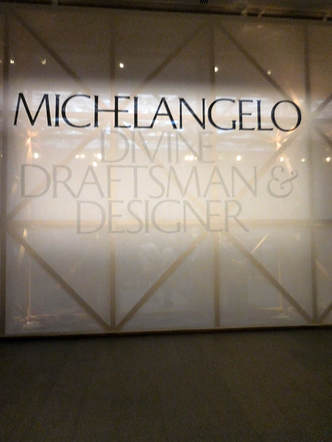 “Michelangelo: Divine Draftsman and Designer” at the Metropolitan Museum of Art presents some 200 works by Michelangelo and his contemporaries. It includes 133 of Michelangelo's drawing as well as three of his marble sculptures gathered from 48 museums and private collections. It is a monumental exhibit. Although Michelangelo considered himself to be primarily a sculptor in marble, he was also a painter and an architect. In this exhibition, we see that the foundation of his art in all of these disciplines was drawing. But more than mere draftsmanship, his drawing reflected a quality of design. The exhibition uses the Italian word disego to capture this concept. Very few of the works in this exhibition were meant for public display. Rather, they were preparatory drawings made in order to work out ideas that would be used in paintings or sculptures. Others served to illustrate ideas for buildings. Because they were made further back in the creative process, they reveal something of how Michelangelo developed his ideas. To illustrate how some of the drawings led to finished works, the exhibit has a one quarter size reproduction of the ceiling of the Sistine Chapel displayed ion the ceiling of one of the galleries. Visitors can look up from Michelangelo's drawing and see how that idea was used in the final masterpiece. The exhibit also places the drawings in context. For example, the exhibit is open about Michelangelo's love of young men and explains that his “divine heads” were drawings that he did of those men and as presents for them. It also discusses his platonic relationship with the poet Vittoria Colonna and presents the drawings that he did when he came under her influence. It also looks at his relationship with other artists. To illustrate, Raphael began to achieve success in Rome at a time when Michelangelo was living in Florence. In order to compete with Raphael, Michelangelo fed ideas to the painter Sebastiano. Michelngelo's powerful marble bust of Brutus is presented along with a Roman statue that inspired Michelangelo and a bust of Julius Caesar made by a contemporary of Michelangelo. This allows us to see the debt that Michelangelo owed to the ancients as well as how his work broke with what was fashionable when Michelangelo created his Brutus. Michelangelo is one of the best known artists of all time. Yet, this exhibit sheds light on his creative process and career that may not have been generally appreciated before. Comments are closed.
|
AuthorRich Wagner is a writer, photographer and artist. Archives
November 2018
Categories
All
|


 RSS Feed
RSS Feed